| START
OF A NEW AGE
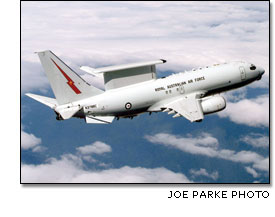 On
May 20, a 25-year-old Australian dream became reality. That's when-ahead
of schedule-the first Project Wedgetail 737-700 aircraft took to the skies
over Seattle on its initial flight and launched a new era in airborne
surveillance and command and control. On
May 20, a 25-year-old Australian dream became reality. That's when-ahead
of schedule-the first Project Wedgetail 737-700 aircraft took to the skies
over Seattle on its initial flight and launched a new era in airborne
surveillance and command and control.
Since the late 1970s, Australia has been working toward acquiring this
kind of capability. But it wasn't until a convergence of the right platform
and right technology that it became affordable to Australia and other
potential customers. The end result was the pairing of the Boeing Next-Generation
737-700 aircraft with Northrop Grumman's Multi-role Electronically Scanned
Array antenna.
The 737-700 features 21st-century avionics, navigation equipment and
flight deck. It has the speed, range, endurance and payload capacity to
meet the requirements of the airborne early warning and control mission.
Because the 737 is the most popular commercial jet in the world, there's
a global support network.
FULL STORY >>

EYES AND EARS ABOVE
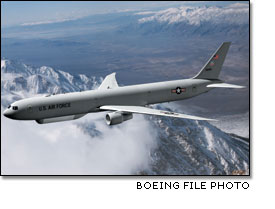 History
abounds with examples of commanders who won or lost battles depending
on the kind of information they obtained about enemy intentions. The pursuit
of information superiority on the battlefield is ancient, but the way
that information is obtained and exchanged across the U.S. Armed Forces
today is changing with the force of a tidal wave-particularly in Command
and Control (C2). History
abounds with examples of commanders who won or lost battles depending
on the kind of information they obtained about enemy intentions. The pursuit
of information superiority on the battlefield is ancient, but the way
that information is obtained and exchanged across the U.S. Armed Forces
today is changing with the force of a tidal wave-particularly in Command
and Control (C2).
The drive today is to speed up the information flow across the battle
space and slash the time needed to receive data about a threat, analyze
it and then send it to warfighters to deal with. Quick strategic decisions
result in battles won and lives saved.
Command and Control, defined generically in terms of national defense,
is the exercise of authority and direction by designated commander(s)
over assigned forces in the accomplishment of a mission. Command is the
authority vested in an individual for the direction, coordination and
control of military forces. Control is the means by which command is exercised.
FULL STORY >>

For the love of the job
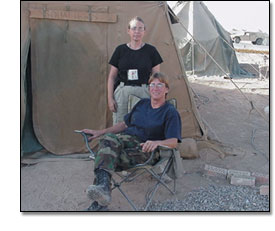 Connie
Goddard and Kathy Crain understood they were in for a serious adventure
when they signed on to provide support to the U.S. Army during combat
in Iraq. Connie
Goddard and Kathy Crain understood they were in for a serious adventure
when they signed on to provide support to the U.S. Army during combat
in Iraq.
Women had filled support and combat assignments before, but this teaming
of Goddard and Crain, who work in the Aerospace Support business unit
of Integrated Defense Systems at Mesa, Ariz., marked the first Boeing
all-female support team in a combat zone.
During Operation Iraqi Freedom, Goddard and Crain were in Tikrit, Iraq,
in the middle of the desert from October 2003 to March 2004 with the D
company of the 1st Battalion, 4th Infantry Division.
Goddard provided Apache Longbow helicopter technical expertise, and Crain
provided in-theater logistics support. They also provided some humanitarian
support when they helped coordinate a clothing drive for Iraqi children.
FULL STORY >>

The hand of experience
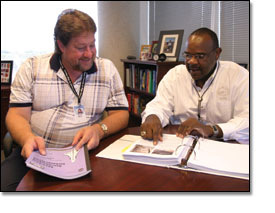 Engineering
acumen, program management expertise and long memories are the hallmarks
of a team of space industry leaders who are lending Mission Assurance
support to Space Shuttle return-to-flight activities at Integrated Defense
Systems. Engineering
acumen, program management expertise and long memories are the hallmarks
of a team of space industry leaders who are lending Mission Assurance
support to Space Shuttle return-to-flight activities at Integrated Defense
Systems.
These experts, including retired NASA and Boeing program directors and
engineers, are conducting emeritus reviews as part of Houston's Mission
Assurance activities that are key to getting the Space Shuttle flying
again.
The Mission Assurance discipline at IDS is based on three key elements:
independent reviews and assessments, independent risk assessments and
technical integrity verification. Its goal is to identify program risks
and ensure that all needed steps are taken to mitigate them adequately.
The work of the emeritus group is one of the ways that the common IDS
Mission Assurance approach is being applied to return-to-flight activities.
The group's leader is Wayne Littles, former director of the Marshall Space
Flight Center in Huntsville, Ala. During a distinguished 30-year NASA
career, Littles also served as NASA's chief engineer and the agency's
associate administrator for space flight. In that role, he directed the
planning, development and operation of the Space Shuttle, Spacelab and
International Space Station programs.
FULL STORY >>

A little DAP
will do ya
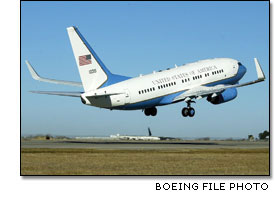 The
Boeing Derivative Airplane Programs organization recently received the
Washington State Quality Award, an advanced-level award for organizations
that have demonstrated significant progress toward business excellence.
The DAP award application went through an intensive evaluation and scoring
process by the WSQA Board of Examiners. The award was presented by Washington
State Gov. Gary Locke. The
Boeing Derivative Airplane Programs organization recently received the
Washington State Quality Award, an advanced-level award for organizations
that have demonstrated significant progress toward business excellence.
The DAP award application went through an intensive evaluation and scoring
process by the WSQA Board of Examiners. The award was presented by Washington
State Gov. Gary Locke.
This commendation is one of the latest for DAP-a Boeing Integrated Defense
Systems organization that's earned a stellar reputation for creativity,
innovation and world-class customer service in a high-velocity environment.
Located in Seattle, Derivative Airplane Programs includes three commercial
airplane models that are reconfigured to meet military requirements.
FULL STORY >>
|

